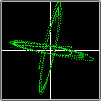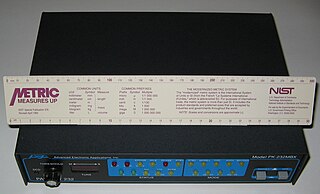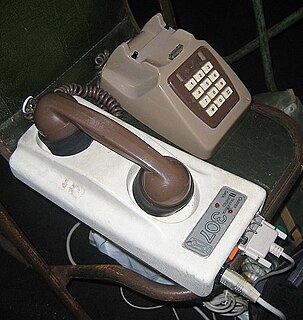Q15X25 is a communications protocol for sending data over a radio link. It was designed by amateur radio operator Pawel Jalocha, SP9VRC, to be an open communications standard. Like all amateur radio communications modes, this protocol uses open transmissions which can be received and decoded by anyone with similar equipment. Q15X25 is a form of packet radio. It can be used to interconnect local VHF AX.25 packet networks over transcontinental distances. Anyone can design or adapt the open-source software to develop their own Q15X25 system.

Amateur radio, also known as ham radio, describes the use of radio frequency spectrum for purposes of non-commercial exchange of messages, wireless experimentation, self-training, private recreation, radiosport, contesting, and emergency communication. The term "amateur" is used to specify "a duly authorised person interested in radioelectric practice with a purely personal aim and without pecuniary interest;" and to differentiate it from commercial broadcasting, public safety, or professional two-way radio services.

Packet radio is a form of packet switching technology used to transmit digital data via wireless communications. Packet radio uses the same concepts of data transmission using datagrams that are fundamental to communications on the Internet, as opposed to older techniques used by dedicated or switched circuits. Packet radio can be used over long distances without the need for a physical connection between stations. Packet radio can also be used for mobile communications.

Open-source software (OSS) is a type of computer software in which source code is released under a license in which the copyright holder grants users the rights to study, change, and distribute the software to anyone and for any purpose. Open-source software may be developed in a collaborative public manner. Open-source software is a prominent example of open collaboration.
Q15X25 is a digital signal processor-intensive mode designed to pass AX.25 packets on HF with speed and reliability much greater than traditional HF ARQ modems. It uses 15 QPSK modulated carriers separated by 125 Hertz, each modulated at 83.333 baud. Q15X25 uses forward error correction (FEC), and like MT63, uses time- and frequency-interleaving in order to avoid most error sources. The raw transmission data rate is typically 2500 bit/s.

A digital signal processor (DSP) is a specialized microprocessor, with its architecture optimized for the operational needs of digital signal processing.
AX.25 is a data link layer protocol originally derived from layer 2 of the X.25 protocol suite and designed for use by amateur radio operators. It is used extensively on amateur packet radio networks.
Automatic repeat request (ARQ), also known as automatic repeat query, is an error-control method for data transmission that uses acknowledgements and timeouts to achieve reliable data transmission over an unreliable service. If the sender does not receive an acknowledgment before the timeout, it usually re-transmits the packet until the sender receives an acknowledgment or exceeds a predefined number of retransmissions.
Typically the DSP based receiver and transmitter modulator or codec is implemented as PC software that uses a sound card to connect directly to an SSB transceiver. Linux implementations are usually called "newpsk" or "newqpsk". MixW, a multipurpose communications control and digital modes package on Windows can implement Kiss and/or "TCP/IP over X.25" on either traditional 300 baud, 1200 baud and 2400 baud FSK packet "modems" implemented as DSP via sound card or over Q15X25. The "FlexNet" Windows packet software also has a newqpsk / Q15X25 option.

Linux is a family of free and open-source software operating systems based on the Linux kernel, an operating system kernel first released on September 17, 1991 by Linus Torvalds. Linux is typically packaged in a Linux distribution.
As with any amateur radio transmission, anyone can listen/decode Q15X25 transmissions, but an amateur radio operation license is required for transmission.
Frequencies (all USB) in use are (MixW center about 1350 Hz higher):
| Wavelength | Frequency |
|---|
| 80 m | 3585 kHz |
| 40 m | 7035 kHz |
| 20 m | 14109 kHz |
In electronics and telecommunications, modulation is the process of varying one or more properties of a periodic waveform, called the carrier signal, with a modulating signal that typically contains information to be transmitted. Most radio systems in the 20th century used frequency modulation (FM) or amplitude modulation (AM) for radio broadcast.

Radioteletype (RTTY) is a telecommunications system consisting originally of two or more electromechanical teleprinters in different locations connected by radio rather than a wired link. These machines were superseded by personal computers (PCs) running software to emulate teleprinters. Radioteletype evolved from earlier landline teleprinter operations that began in the mid-1800s. The US Navy Department successfully tested printing telegraphy between an airplane and ground radio station in 1922. Later that year, the Radio Corporation of America successfully tested printing telegraphy via their Chatham, Massachusetts, radio station to the R.M.S. Majestic. Commercial RTTY systems were in active service between San Francisco and Honolulu as early as April 1932 and between San Francisco and New York City by 1934. The US military used radioteletype in the 1930s and expanded this usage during World War II. From the 1980s, teleprinters were replaced by computers running teleprinter emulation software.

PSK31 or "Phase Shift Keying, 31 Baud", also BPSK31 and QPSK31, is a popular computer-sound card-generated radioteletype mode, used primarily by amateur radio operators to conduct real-time keyboard-to-keyboard chat, most often using frequencies in the high frequency amateur radio bands (near-shortwave). PSK31 is distinguished from other digital modes in that it is specifically tuned to have a data rate close to typing speed, and has an extremely narrow bandwidth, allowing many conversations in the same bandwidth as a single voice channel. This narrow bandwidth also concentrates the RF energy in a very narrow space thus allowing relatively low-power equipment to communicate globally using the same skywave propagation used by shortwave radio stations.
The Hellschreiber, Feldhellschreiber or Typenbildfeldfernschreiber is a facsimile-based teleprinter invented by Rudolf Hell. Compared to contemporary teleprinters that were based on typewriter systems and were mechanically complex and expensive, the Hellschreiber was much simpler and more robust, with only two moving parts. It has the added advantage of being capable of providing intelligible communication even over very poor quality radio or cable links, where voice or other teledata would be unintelligible.

A terminal node controller (TNC) is a device used by amateur radio operators to participate in AX.25 packet radio networks. It is similar in function to the Packet Assembler/Disassemblers used on X.25 networks, with the addition of a modem to convert baseband digital signals to audio tones.
The Bell 103 modem or Bell 103 dataset was the second commercial modem for computers, released by AT&T Corporation in 1962. It allowed digital data to be transmitted over regular unconditioned telephone lines at a speed of 300 bits per second. It followed the introduction of the 110 baud Bell 101 dataset in 1958.
The Bell 202 modem was an early (1976) modem standard developed by the Bell System. It specifies audio frequency-shift keying (AFSK) to encode and transfer data at a rate of 1200 bits per second, half-duplex. These signalling protocols, also used in third-party modems, are referred to generically as Bell 202 modulation, and any device employing it as Bell-202-compatible.
PACTOR is a radio modulation mode used by amateur radio operators, marine radio stations, military or government users such as the Department of Homeland Security, and radio stations in isolated areas to send and receive digital information via radio. A robust network of PACTOR stations has been established to relay data between radio stations and the Internet, extending Internet access to sea based and other isolated users, led by volunteers involved with Winlink, under the auspicies of a Florida non-profit, ARSFI. PACTOR utilizes a combination of simple FSK modulation, and the ARQ protocol for robust error detection and data throughput. Generational improvements to PACTOR include PACTOR II, PACTOR III, and PACTOR IV which are capable of higher speed transmission.
The AMPRNet is a name used by amateur radio operators for computer networks connected over amateur radio. Other names for the network include IPv4 Network 44/8 and Network 44.
Winlink, or formally, Winlink Global Radio Email, also known as the Winlink 2000 Network, is a worldwide radio messaging system that uses amateur-band radio frequencies and government frequencies to provide radio interconnection services that include email with attachments, position reporting, weather bulletins, emergency and relief communications, and message relay. The system is built and administered by volunteers and is financially supported by the Amateur Radio Safety Foundation Inc., an American public-benefit entity and 501(c)(3) non-profit organization.
WSJT is a computer program used for weak-signal radio communication between amateur radio operators. The program was initially written by Joe Taylor, K1JT, but is now open source and is developed by a small team. The digital signal processing techniques in WSJT make it substantially easier for amateur radio operators to employ esoteric propagation modes, such as high speed meteor scatter and moonbounce.
WINMOR is a radio transmission protocol intended to be used in the Winlink 2000 Global Radio E-mail System by amateur radio operators, marine radio stations, and radio stations in isolated areas. WINMOR will complement the PACTOR modes in the high frequency portion of the Winlink system. WINMOR debuted at the 2008 ARRL / TAPR Digital Communications Conference. Unlike PACTOR II & III, only a simple computer soundcard-to-radio interface is required, as compared to PACTOR's relatively expensive external terminal node controller. It has two modes, either 500 or 1600 Hertz in bandwidth, and provides ARQ speeds ranging from 67 to at least 1300 bits per second, similar to PACTOR's various modes. It is fully documented and without restrictions or license issues preventing anyone from using the protocol in other software. WINMOR supports both connected (ARQ) and FEC (broadcast) modes.

A modem is a hardware device that converts data between transmission media so that it can be transmitted from computer to computer. The goal is to produce a signal that can be transmitted easily and decoded to reproduce the original digital data. Modems can be used with any means of transmitting analog signals from light-emitting diodes to radio. A common type of modem is one that turns the digital data of a computer into modulated electrical signal for transmission over telephone lines and demodulated by another modem at the receiver side to recover the digital data.
FX.25 is a protocol extension to the AX.25 Link Layer Protocol. FX.25 provides a Forward Error Correction (FEC) capability while maintaining legacy compatibility with non-FEC equipment. FX.25 was created by the Stensat Group in 2005, and was presented as a technical paper at the 2006 TAPR Digital Communications Conference in Tucson, AZ.
AMSAT-OSCAR 16, also known as AO-16 and PACSAT, is the in-orbit name designation of an amateur radio satellite of the OSCAR series. It was built by AMSAT and was launched on 22 January 1990 from Kourou, French Guiana on an Ariane 4 launch vehicle. It is in sun synchronous low Earth orbit.
KISS is a protocol for communicating with a serial terminal node controller (TNC) device used for amateur radio. This allows the TNC to combine more features into a single device and standardizes communications. KISS was developed by Mike Chepponis and Phil Karn to allow transmission of AX.25 packet radio frames containing IP packets over an asynchronous serial link, for use with the KA9Q NOS program.

Fldigi, the Fast Light Digital modem application, is a free and open-source program which allows an ordinary computer's sound card to be used as a simple two-way data modem. The software is mostly used by amateur radio operators who connect the microphone and headphone connections of an amateur radio SSB transceiver or an FM two way radio to the computer's headphone and microphone connections, respectively.










